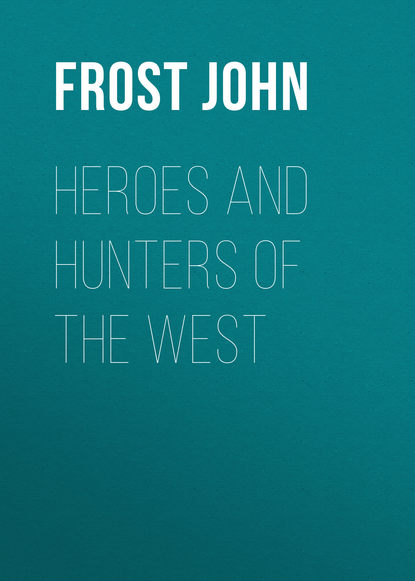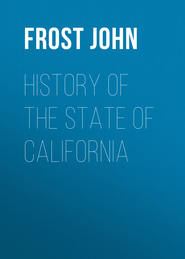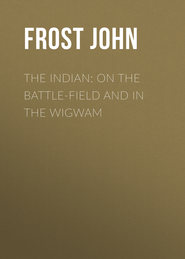По всем вопросам обращайтесь на: info@litportal.ru
(©) 2003-2024.
✖
Heroes and Hunters of the West
Настройки чтения
Размер шрифта
Высота строк
Поля
The warriors painted themselves in the most frightful colors, and performed a war dance, with the usual accompaniments. A stake, painted in alternate stripes of black and vermilion, was fixed in the ground, and the dancers moved in rapid but measured evolutions around it. They recounted, with great energy, the wrongs they had received from the whites. – Their lands had been taken from them – their corn cut up – their villages burnt – their friends slaughtered – every injury which they had received was dwelt upon, until their passions had become inflamed beyond control. Suddenly, Chickatommo darted from the circle of dancers, and with eyes flashing fire, ran up to the spot where Johnston was sitting, calmly contemplating the spectacle before him. When within reach he struck him a furious blow with his fist, and was preparing to repeat it, when Johnston seized him by the arms, and hastily demanded the cause of such unprovoked violence. Chickatommo, grinding his teeth with rage, shouted “Sit down, sit down!” Johnston obeyed, and the Indian, perceiving the two children within ten steps of him, snatched up a tomahawk, and advanced upon them with a quick step, and a determined look. The terrified little creatures instantly arose from the log on which they were sitting, and fled into the woods, uttering the most piercing screams, while their pursuer rapidly gained upon them with uplifted tomahawk. The girl, being the youngest, was soon overtaken, and would have been tomahawked, had not Messhawa bounded like a deer to her relief. He arrived barely in time to arrest the uplifted tomahawk of Chickatommo, after which, he seized him by the collar and hurled him violently backward to the distance of several paces. Snatching up the child in his arms, he then ran after the brother, intending to secure him likewise from the fury of his companion, but the boy, misconstruing his intention, continued his flight with such rapidity, and doubled several times with such address, that the chase was prolonged to the distance of several hundred yards. At length Messhawa succeeded in taking him. The boy, thinking himself lost, uttered a wild cry, which was echoed by his sister, but both were instantly calmed. Messhawa took them in his arms, spoke to them kindly, and soon convinced them that they had nothing to fear from him. He quickly reappeared, leading them gently by the hand, and soothing them in the Indian language, until they both clung to him closely for protection.
No other incident disturbed the progress of the ceremonies, nor did Chickatommo appear to resent the violent interference of Messhawa.
After undergoing many hardships, Johnston was taken to Sandusky, where he was ransomed by a French trader. Messhawa took leave of his young captive with many expressions of esteem and friendship. This noble chief was in the battle of the Fallen Timber and afterwards became a devoted follower of the great Tecumseh – thus proving that while he was as humane as a civilized man, he was patriotic and high-spirited enough to resent the wrongs of his people. He was killed at the battle of the Thames, where the power of the Shawnees was for ever crushed.
Joseph Logston
Big Joe Logston was a noted character in the early history of the west. He was born and reared among the Alleghany mountains, near the source of the north branch of the Potomac, some twenty or thirty miles from any settlement. He was tall, muscular, excelled in all the athletic sports of the border, and was a first-rate shot. Soon after Joe arrived at years of discretion, his parents died, and he went out to the wilds of Kentucky. There, Indian incursions compelled him to take refuge in a fort. This pent up life was not at all to Joe’s taste. He soon became very restless, and every day insisted on going out with others to hunt up cattle. At length no one would accompany him, and he resolved to go out alone. He rode the greater part of the day without finding any cattle, and then concluded to return to the fort. As he was riding along, eating some grapes, with which he had filled his hat, he heard the reports of the two rifles; one ball passed through the paps of his breast, which were very prominent, and the other struck the horse behind the saddle, causing the beast to sink in its tracks.
Joe was on his feet in an instant and might have taken to his heels with the chances of escape greatly in his favor. But to him flight was never agreeable. The moment the guns were fired, an Indian sprang forward with an uplifted tomahawk; but as Joe raised his rifle, the savage jumped behind two saplings, and kept springing from one to the other to cover his body. The other Indian was soon discovered behind a tree loading his gun. When in the act of pushing down his bullet, he exposed his hips and Joe fired a load into him. The first Indian then sprang forward and threw his tomahawk at the head of the white warrior, who dodged it. Joe then clubbed his gun and made at the savage, thinking to knock him down. In striking, he missed, and the gun now reduced to the naked barrel, flew out of his hands. The two men then sprang at each other with no other weapons than those of nature. A desperate scuffle ensued. Joe could throw the Indian down, but could not hold him there. At length, however, by repeated heavy blows, he succeeded in keeping him down, and tried to choke him with the left hand while he kept the right free for contingencies. Directly, Joe saw the savage trying to draw a knife from its sheath, and waiting till it was about half way out, he grasped it quickly and sank it up to the handle in the breast of his foe, who groaned and expired.
Springing to his feet, Joe saw the Indian he had crippled, propped against a log, trying to raise his gun to fire, but falling forward, every time he made the attempt. The borderer, having enough of fighting for one day, and not caring to be killed by a crippled Indian, made for the fort, where he arrived about nightfall. He was blood and dirt from crown to toe, and without horse, hat, or gun.
The next morning a party went to Joe’s battle-ground. On looking round, they found a trail, as if something had been dragged away, and at a little distance they came upon the big Indian, covered up with leaves. About a hundred yards farther, they found the Indian Joe had crippled, lying on his back, with his own knife sticking up to the hilt in his body, just below the breast bone, evidently to show that he had killed himself. Some years after this fight, Big Joe Logston lost his life in a contest with a gang of outlaws. He was one of those characters who were necessary to the settlement of the west, but who would not have been highly esteemed in civilized society.
Jesse Hughes
Jesse Hughes was born and reared in Clarksburgh, Harrison county, Virginia, on the head-waters of the Monongahela. He was a light-built, active man, and from his constant practice became one of the best hunters and Indian fighters on the frontier. Having a perfect knowledge of all the artifices of the Indians, he was quick to devise expedients to frustrate them. Of this, the following exploit is an illustration. At a time of great danger from Indian incursions, when the citizens in the neighborhood where in a fort at Clarksburgh, Hughes one morning observed a lad very hurriedly engaged in fixing his gun.
“Jim,” said he, “what are you doing that for?”
“I am going to shoot a turkey that I hear gobbling on the hill side,” replied Jim.
“I hear no turkey,” said Hughes.
“Listen,” said Jim. “There, didn’t you hear it? Listen again!”
“Well,” said Hughes, after hearing it repeated, “I’ll go and kill it.”
“No you won’t. It’s my turkey. I heard it first,” said Jim.
“Well,” said Hughes, “but you know I am the best marksman; and besides, I don’t want the turkey, you may have it.”
The lad then agreed that Hughes should go and kill it for him. Hughes went out of the fort on the side that was farthest from the supposed turkey, and running along the river, went up a ravine and came in on the rear, where, as he expected, he saw an Indian, sitting on a chestnut stump, surrounded by sprouts, gobbling and watching to see if any one would come from the fort to kill the turkey. Hughes crept up and shot him dead. The successful ranger then took off the scalp, and went into the fort, where Jim was waiting for the prize.
“There, now,” said Jim, “you have let the turkey go. I would have killed it if I had gone.”
“No,” said Hughes, “I didn’t let it go,” and he threw down the scalp. “There, take your turkey, Jim; I don’t want it.”
The lad nearly fainted, as he thought of the death he had so narrowly escaped, owing to the keen perception and good management of Mr. Hughes.
The sagacity of our border hero was fully proved upon another occasion. About 1790, the Indians visited Clarksburgh, in the night, and contrived to steal a few horses, with which they made a hasty retreat. About daylight the next morning, a party of twenty-five or thirty men, among whom was Jesse Hughes, started in pursuit. They found a trail just outside of the settlement, and from the signs, supposed that the marauding party consisted of eight or ten Indians. A council was held to determine how the pursuit should be continued. Mr. Hughes was opposed to following the trail. He said he could pilot the party to the spot where the Indians would cross the Ohio, by a nearer way than the enemy could go, and thus render success certain. But the captain of the party insisted on following the trail. Mr. Hughes then pointed out the dangers of such a course. Suddenly, the captain, with unreasonable obstinacy, called aloud to those who were brave to follow him and let the cowards go home. Hughes knew the captain’s remark was intended for him, but smothered his indignation and went on with the party.
They had not pursued very far when the trail went down a drain, where the ridge on one side was very steep, with a ledge of rocks for a considerable distance. On the top of the cliff, two Indians lay in ambush, and when the company got opposite to them, they made a noise, which caused the whites to stop; that instant two of the company were mortally wounded, and before the rangers could get round to the top of the cliff, the Indians made their escape with ease. This was as Hughes had predicted. All then agreed that the plan rejected by the captain was the best, and urged Hughes to lead them to the Ohio river. This he consented to do, though fearful that the Indians would cross before he could reach the point. Leaving some of the company to take care of the wounded men, the party started, and arrived at the Ohio the next day, about an hour after the Indians had crossed. The water was yet muddy in the horses’ trails, and the rafts that the red men had used were floating down the opposite shore. The company was now unanimous for returning home. Hughes said he wanted to find out who the cowards were. He said that if any of them would go with him, he would cross the river, and scalp some of the Indians. Not one could be found to accompany the daring ranger, who thus had full satisfaction for the captain’s insult. He said he would go by himself, and take a scalp, or leave his own with the savages. The company started for home, and Hughes went up the river three or four miles, then made a raft, crossed the river, and camped for the night. The next day, he found the Indian trail, pursued it very cautiously, and about ten miles from the Ohio, came upon the camp. There was but one Indian in it; the rest were all out hunting. The red man was seated, singing, and playing on some bones, made into a rude musical instrument, when Hughes crept up and shot him. The ranger then took the scalp, and hastened home in triumph, to tell his adventures to his less daring companions.
Siege of Fort Henry
The siege of Fort Henry, at the mouth of Wheeling creek, in the year 1777, is one of the most memorable events in Indian warfare – remarkable for the indomitable bravery displayed by the garrison in general, and for some thrilling attendant incidents. The fort stood immediately on the left bank of the Ohio river, about a quarter of a mile above Wheeling creek, and at much less distance from an eminence which rises abruptly from the bottom land. The space inclosed was about three quarters of an acre. In shape the fort was a parallelogram, having a block-house at each corner with lines of pickets eight feet high between. Within the inclosures was a store-house, barrack-rooms, garrison-well, and a number of cabins for the use of families. The principal entrance was a gateway on the eastern side of the fort. Much of the adjacent land was cleared and cultivated, and near the base of the hill stood some twenty-five or thirty cabins, which form the rude beginning of the present city of Wheeling. The fort is said to have been planned by General George Rogers Clarke; and was constructed by Ebenezer Zane and John Caldwell. When first erected, it was called Fort Fincastle but the name was afterwards changed in compliment to Patrick Henry the renowned orator and patriotic governor of Virginia.
At the time of the commencement of the siege, the garrison of Fort Henry numbered only forty-two men, some of whom were enfeebled by age while others were mere boys. All, however, were excellent marksmen, and most of them, skilled in border warfare. Colonel David Shepherd, was a brave and resolute officer in whom the borderers had full confidence. The store-house was well-supplied with small arms, particularly muskets, but sadly deficient in ammunition.
In the early part of September, 1777, it was ascertained that a large Indian army was concentrating on the Sandusky river, under the command of the bold, active, and skilful renegade, Simon Girty. Colonel Shepherd had many trusty and efficient scouts on the watch; but Girty deceived them all and actually brought his whole force of between four and five hundred Indians before Fort Henry before his real object was discovered.







